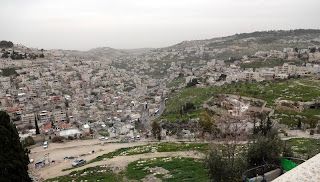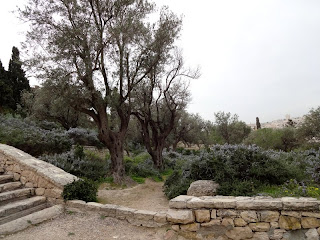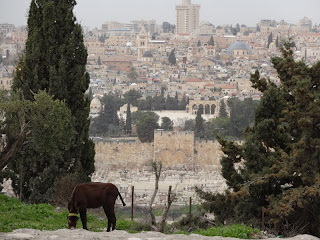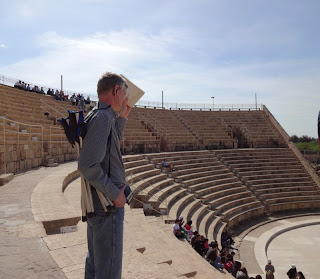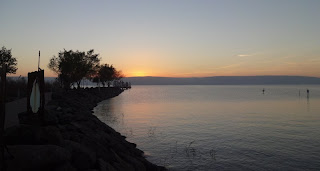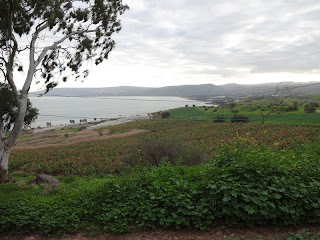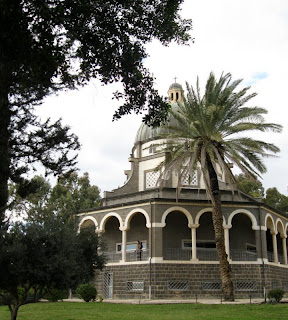The remains of Caiaphas's palace, where Jesus was taken after his betrayal and arrest.
There is also a church (French) build over the two-thousand-year-old rooms where prisoners were held.
In the church courtyard, Peter's denial is remembered. (At the top of the column is a rooster).
As we walked down from the Mount of Olives, thorny vines grew at the roadside.
The traditional site for the crucifixion is at the Church of the Holy Sepulcher, inside the city wall. Several denominations share the site, with so many people milling about and a lot of confusion.
Scripture clearly states Jesus' crucifixion was outside the city wall.
So we went instead to a rocky cliff a short walk from the Damascus Gate. A place where
stonings could have taken place, so, already a place of execution.
A place close to a major road, as the Romans' purpose in crucifying convicts was
to instill fear in the populace through a public, horrific execution.
And a place with caves that used to look like eyes, nose and mouth--it could look like a skull.
It's only been in the past hundred years or so that this site has gained credence as the probable Golgotha.
It's also likely that the crosses were placed by the road, at the bottom of the hill,
instead of on top, so that passersby could cast insults at the dying men.
(There's a Muslim cemetery on top of the hill now).
About 50 yards from Golgotha is the Garden Tomb ("nearby").
Fairly recent archaeological discoveries
brought this area to everyone's attention.
The crucifixion was hurried because of the "preparation for the sabbath" according to three of the Gospels,
but in John, it mentions preparation for the Passover. And the Passover has the same rules in place as
a Sabbath--no travel, work, etc. It would seem that this week, there could have been two "high" days in a row--Passover on Thursday evening to Friday, then the regular Sabbath from Friday evening to Saturday.
By the way, Joseph of Arimethea and Nicodemus, by handling the dead, were "unclean" and could
not participate in either the Passover or the Sabbath. They also marked themselves as followers of Christ though the rest of the Sanhedrin obviously were opposed. It was a very brave thing they did.
The crucifixion was hurried because of the "preparation for the sabbath" according to three of the Gospels,
but in John, it mentions preparation for the Passover. And the Passover has the same rules in place as
a Sabbath--no travel, work, etc. It would seem that this week, there could have been two "high" days in a row--Passover on Thursday evening to Friday, then the regular Sabbath from Friday evening to Saturday.
By the way, Joseph of Arimethea and Nicodemus, by handling the dead, were "unclean" and could
not participate in either the Passover or the Sabbath. They also marked themselves as followers of Christ though the rest of the Sanhedrin obviously were opposed. It was a very brave thing they did.
The burial niches. From the scriptural description, the far left one would have been
where the Savior's body lay, and where the folded burial clothing was left.
And the tomb is empty! How wonderful that is!
Although there were a lot of people gathered to see this tomb, the garden setting was beautiful.
The walled-in area on the green hillside across the little valley is likely where the potter's field was that was purchased with the betrayal money that Judas gave back to the Jewish leaders. (Looking southward from
the area of Caiaphas' palace).
***
This little valley is called Hinnom. Sometimes other syllables are added to it to denote it as "Hell".
It was the area where garbage was continually burning, with terrible odors.
This is probably the comparison for the fire and brimstone associated with the "lower realm".
It was also the place where the ancient Palestinians worshiped Molech,
sacrificing their children by fire.
How interesting that this area is where Judas ended his life.








